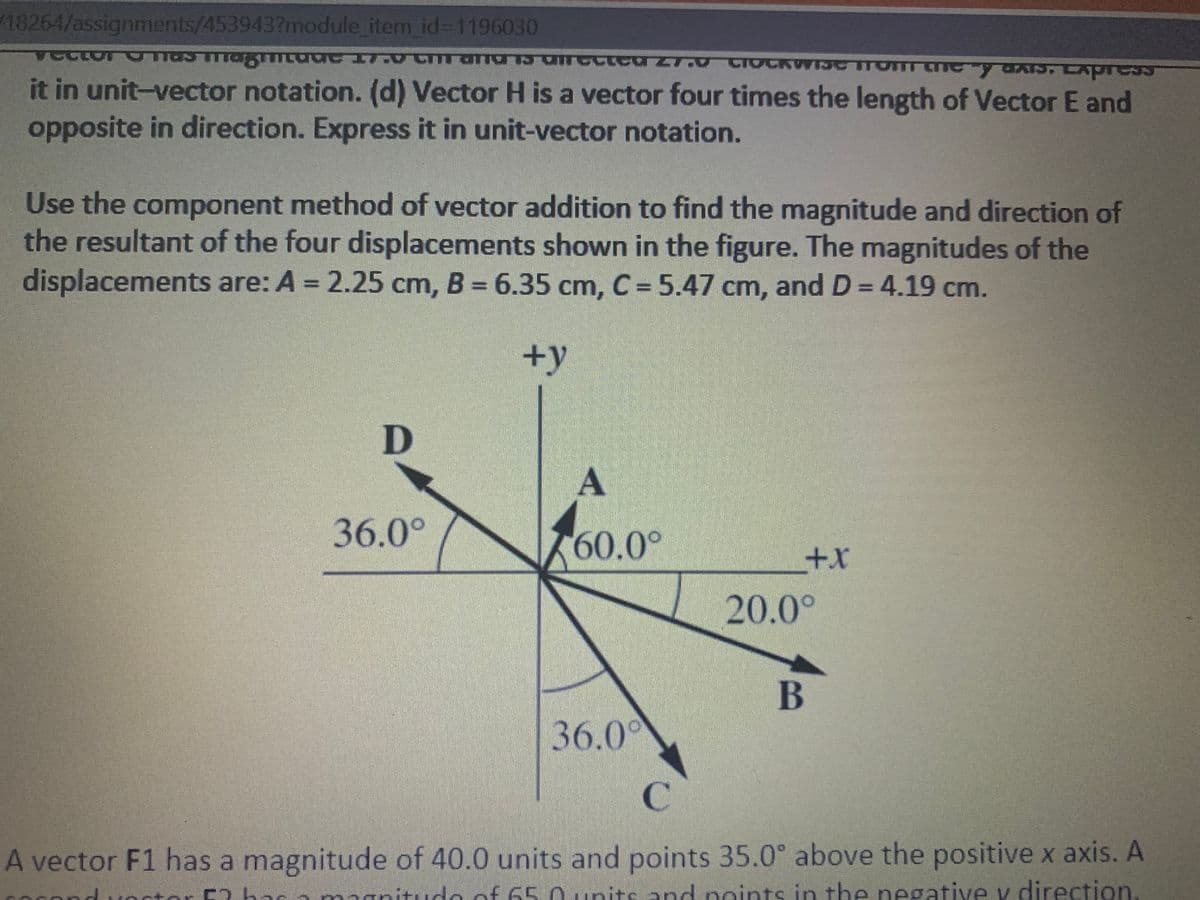vector E an opposite in direction. Express it in unit-vector notation. Use the component method of vector addition to find the magnitude and direction of the resultant of the four displacements shown in the figure. The magnitudes of the displacements are: A = 2.25 cm, B = 6.35 cm, C = 5.47 cm, and D = 4.19 cm. %3D %3D +y D А 36.0° 60.0° x+ 20.0° 36.0 C A vector F1 has a magnitude of 40.0 units and points 35.0° above the positive x axis. diroctio
vector E an opposite in direction. Express it in unit-vector notation. Use the component method of vector addition to find the magnitude and direction of the resultant of the four displacements shown in the figure. The magnitudes of the displacements are: A = 2.25 cm, B = 6.35 cm, C = 5.47 cm, and D = 4.19 cm. %3D %3D +y D А 36.0° 60.0° x+ 20.0° 36.0 C A vector F1 has a magnitude of 40.0 units and points 35.0° above the positive x axis. diroctio
Physics for Scientists and Engineers: Foundations and Connections
1st Edition
ISBN:9781133939146
Author:Katz, Debora M.
Publisher:Katz, Debora M.
Chapter3: Vectors
Section: Chapter Questions
Problem 33PQ
Related questions
Question

Transcribed Image Text:18264/assignments/453943?module item id%3D1196030
SRILC
it in unit-vector notation. (d) Vector H is a vector four times the length of Vector E and
opposite in direction. Express it in unit-vector notation.
Use the component method of vector addition to find the magnitude and direction of
the resultant of the four displacements shown in the figure. The magnitudes of the
displacements are: A = 2.25 cm, B = 6.35 cm, C = 5.47 cm, and D= 4.19 cm.
+y
D
A
36.0°
60.0°
x+
20.0°
B
36.00
C.
A vector F1 has a magnitude of 40.0 units and points 35.0° above the positive x axis. A
anitudo of 65.0 units and noints in the negative v direction
ctor C)
Expert Solution
This question has been solved!
Explore an expertly crafted, step-by-step solution for a thorough understanding of key concepts.
This is a popular solution!
Trending now
This is a popular solution!
Step by step
Solved in 2 steps with 2 images

Knowledge Booster
Learn more about
Need a deep-dive on the concept behind this application? Look no further. Learn more about this topic, physics and related others by exploring similar questions and additional content below.Recommended textbooks for you

Physics for Scientists and Engineers: Foundations…
Physics
ISBN:
9781133939146
Author:
Katz, Debora M.
Publisher:
Cengage Learning

Physics for Scientists and Engineers with Modern …
Physics
ISBN:
9781337553292
Author:
Raymond A. Serway, John W. Jewett
Publisher:
Cengage Learning

Principles of Physics: A Calculus-Based Text
Physics
ISBN:
9781133104261
Author:
Raymond A. Serway, John W. Jewett
Publisher:
Cengage Learning

Physics for Scientists and Engineers: Foundations…
Physics
ISBN:
9781133939146
Author:
Katz, Debora M.
Publisher:
Cengage Learning

Physics for Scientists and Engineers with Modern …
Physics
ISBN:
9781337553292
Author:
Raymond A. Serway, John W. Jewett
Publisher:
Cengage Learning

Principles of Physics: A Calculus-Based Text
Physics
ISBN:
9781133104261
Author:
Raymond A. Serway, John W. Jewett
Publisher:
Cengage Learning

Physics for Scientists and Engineers, Technology …
Physics
ISBN:
9781305116399
Author:
Raymond A. Serway, John W. Jewett
Publisher:
Cengage Learning

Glencoe Physics: Principles and Problems, Student…
Physics
ISBN:
9780078807213
Author:
Paul W. Zitzewitz
Publisher:
Glencoe/McGraw-Hill

University Physics Volume 1
Physics
ISBN:
9781938168277
Author:
William Moebs, Samuel J. Ling, Jeff Sanny
Publisher:
OpenStax - Rice University